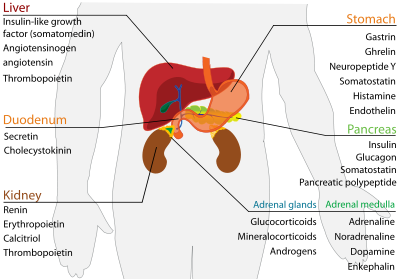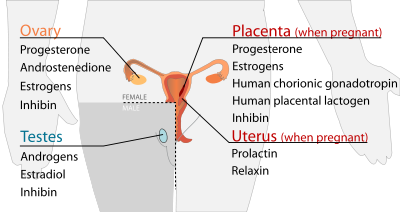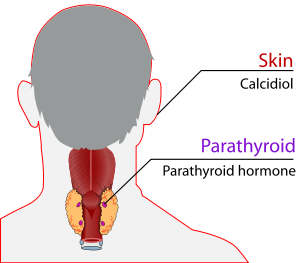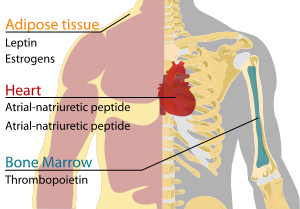- Endocrine system
-
In physiology, the endocrine system is a system of glands, each of which secretes a type of hormone directly into the bloodstream to regulate the body. The endocrine system is in contrast to the exocrine system, which secretes its chemicals using ducts. It derives from the Greek words "endo" meaning inside, within, and "crinis" for secrete. The endocrine system is an information signal system like the nervous system, yet its effects and mechanism are classifiably different. The endocrine system's effects are slow to initiate, and prolonged in their response, lasting for hours to weeks. The nervous system sends information very quickly, and responses are generally short lived. Hormones are substances (chemical mediators) released from endocrine tissue into the bloodstream where they travel to target tissue and generate a response. Hormones regulate various human functions, including metabolism, growth and development, tissue function, and mood. The field of study dealing with the endocrine system and its disorders is endocrinology, a branch of internal medicine.
Features of endocrine glands are, in general, their ductless nature, their vascularity, and usually the presence of intracellular vacuoles or granules storing their hormones. In contrast, exocrine glands, such as salivary glands, sweat glands, and glands within the gastrointestinal tract, tend to be much less vascular and have ducts or a hollow lumen.
In addition to the specialised endocrine organs mentioned above, many other organs that are part of other body systems, such as the kidney, liver, heart and gonads, have secondary endocrine functions. For example the kidney secretes endocrine hormones such as erythropoietin and renin.
The endocrine system is made of a series of glands that produce chemicals called hormones. A number of glands that signal each other in sequence is usually referred to as an axis, for example, the hypothalamic-pituitary-adrenal axis.
Contents
Endocrine organs and secreted hormones
Central nervous system
Hypothalamus
Secreted hormone Abbreviation Produced by Effect Thyrotropin-releasing hormone
(Prolactin-releasing hormone)TRH,, or Parvocellular neurosecretory neurons Stimulate thyroid-stimulating hormone (TSH) released from anterior pituitary (primarily)
Stimulate prolactin release from anterior pituitaryDopamine
(Prolactin-inhibiting hormone)DA or PIH Dopamine neurons of the arcuate nucleus Inhibit prolactin released from anterior pituitary Growth hormone-releasing hormone GHRH Neuroendocrine neurons of the Arcuate nucleus Stimulate Growth hormone (GH) release from anterior pituitary Somatostatin
(growth hormone-inhibiting hormone)SS, GHIH, or SRIF Neuroendocrine cells of the Periventricular nucleus Inhibit Growth hormone (GH) release from anterior pituitary
Inhibit thyroid-stimulating hormone (TSH) release from anterior pituitaryGonadotropin-releasing hormone GnRH or LHRH Neuroendocrine cells of the Preoptic area Stimulate follicle-stimulating hormone () release from anterior pituitary
Stimulate luteinizing hormone (LH) release from anterior pituitaryCorticotropin-releasing hormone CRH or CRF Parvocellular neurosecretory neurons or the Paraventricular Nucleus Stimulate adrenocorticotropic hormone (ACTH) release from anterior pituitary Oxytocin OT or OXT Magnocellular neurosecretory neurons of the Supraoptic Nucleus and Paraventricular Nucleus Uterine contraction
Lactation (letdown reflex)Vasopressin
(antidiuretic hormone)ADH or AVP or VP Parvocellular neurosecretory neurons, Magnocellular neurosecretory neurons of the Paraventricular Nucleus and Supraoptic Nucleus Increases water permeability in the distal convoluted tubule and collecting duct of nephrons, thus promoting water reabsorption and increasing blood volume Melanocyte REleasing Hormone (MRH) Stimulates the secretion of Melanocyte-stimulating hormone from intermediate pituitary lobe.
Pineal body (epiphysis)
Secreted hormone From cells Effect Melatonin Pinealocytes Antioxidant
Monitors the circadian rhythm including inducement of drowsiness and lowering of the middle body temperature sleep cyclePituitary Gland (hypophysis)
Anterior pituitary lobe (adenohypophysis)
Secreted hormone Abbreviation From cells Effect Growth hormone
(somatotropin)GH Somatotrophs Stimulates growth and cell reproduction
Stimulates Insulin-like growth factor 1 release from liverThyroid-stimulating hormone
(thyrotropin)TSH Thyrotrophs Stimulates thyroxine (T4) and triiodothyronine (T3) synthesis and release from thyroid gland
Stimulates iodine absorption by thyroid glandAdrenocorticotropic hormone
(corticotropin)ACTH Corticotrophs Stimulates corticosteroid (glucocorticoid and mineralcorticoid) and androgen synthesis and release from adrenocortical cells Beta-endorphin - Corticotrophs Inhibits perception of pain Follicle-stimulating hormone FSH Gonadotrophs In females: Stimulates maturation of ovarian follicles in ovary
In males: Stimulates maturation of seminiferous tubules
In males: Stimulates spermatogenesis
In males: Stimulates production of androgen-binding protein from Sertoli cells of the testesLuteinizing hormone LH Gonadotrophs In females: Stimulates ovulation
In females: Stimulates formation of corpus luteum
In males: Stimulates testosterone synthesis from Leydig cells (interstitial cells)Prolactin PRL Lactotrophs Stimulates milk synthesis and release from mammary glands
Mediates sexual gratificationMelanocyte-stimulating hormone MSH Melanotropes in the Pars intermedia of the Anterior Pituitary Stimulates melanin synthesis and release from skin/hair melanocytes Posterior pituitary lobe (neurohypophysis)
Secreted hormone Abbreviation From cells Effect Oxytocin Magnocellular neurosecretory cells Uterine contraction
Lactation (letdown reflex)Vasopressin
(antidiuretic hormone)ADH or AVP Parvocellular neurosecretory neurons Increases water permeability in the distal convoluted tubule and collecting duct of nephrons, thus promoting water reabsorption and increasing blood volume Oxytocin and anti-diuretic hormone are not secreted in the posterior lobe, merely stored.
Thyroid
Secreted hormone Abbreviation From cells Effect Triiodothyronine T3 Thyroid epithelial cell (More potent form of thyroid hormone)
Stimulates body oxygen and energy consumption, thereby increasing the basal metabolic rate
Stimulates RNA polymerase I and II, thereby promoting protein synthesisThyroxine
(tetraiodothyronine)T4 Thyroid epithelial cells (Less active form of thyroid hormone)
(Acts as a prohormone to triiodothyronine)
Stimulates body oxygen and energy consumption, thereby increasing the basal metabolic rate
Stimulates RNA polymerase I and II, thereby promoting protein synthesisCalcitonin Parafollicular cells Stimulates osteoblasts and thus bone construction
Inhibits Ca2+ release from bone, thereby reducing blood Ca2+Alimentary system
Stomach
Secreted hormone Abbreviation From cells Effect Gastrin (Primarily) G cells Secretion of gastric acid by parietal cells Ghrelin P/D1 cells Stimulate appetite, secretion of growth hormone from anterior pituitary gland
Neuropeptide Y NPY increased food intake and decreased physical activity. It can be associated with obesity. Somatostatin D cells Suppress release of gastrin, cholecystokinin (CCK), secretin, motilin, vasoactive intestinal peptide (VIP), gastric inhibitory polypeptide (GIP), enteroglucagon Lowers rate of gastric emptying Reduces smooth muscle contractions and blood flow within the intestine.[1]
Histamine ECL cells stimulate gastric acid secretion Endothelin X cells Smooth muscle contraction of stomach[2] Duodenum
Secreted hormone From cells Effect Secretin S cells Secretion of bicarbonate from liver, pancreas and duodenal Brunner's glands Enhances effects of cholecystokinin Stops production of gastric juice
Cholecystokinin I cells Release of digestive enzymes from pancreas Release of bile from gallbladder hunger suppressant
Liver
Secreted hormone Abbreviation From cells Effect Insulin-like growth factor (or somatomedin) (Primarily) IGF Hepatocytes insulin-like effects regulate cell growth and development
Angiotensinogen and angiotensin Hepatocytes vasoconstriction release of aldosterone from adrenal cortex dipsogen.
Thrombopoietin Hepatocytes stimulates megakaryocytes to produce platelets[3] Pancreas
Secreted hormone From cells Effect Insulin (Primarily) β Islet cells Intake of glucose, glycogenesis and glycolysis in liver and muscle from blood intake of lipids and synthesis of triglycerides in adipocytes Other anabolic effects
Glucagon (Also Primarily) α Islet cells glycogenolysis and gluconeogenesis in liver increases blood glucose level
Somatostatin δ Islet cells Inhibit release of insulin[4] Inhibit release of glucagon[4] Suppress the exocrine secretory action of pancreas.
Pancreatic polypeptide PP cells Self regulate the pancreas secretion activities and effect the hepatic glycogen levels. Kidney
Secreted hormone From cells Effect Renin (Primarily) Juxtaglomerular cells Activates the renin-angiotensin system by producing angiotensin I of angiotensinogen Erythropoietin (EPO) Extraglomerular mesangial cells Stimulate erythrocyte production Calcitriol (1,25-dihydroxyvitamin D3) Active form of vitamin D3 Increase absorption of calcium and phosphate from gastrointestinal tract and kidneys inhibit release of PTH
Thrombopoietin stimulates megakaryocytes to produce platelets[3] Adrenal glands
Adrenal cortex
Secreted hormone From cells Effect Glucocorticoids (chiefly cortisol) zona fasciculata and zona reticularis cells Stimulates gluconeogenesis
Stimulates fat breakdown in adipose tissue
Inhibits protein synthesis
Inhibits glucose uptake in muscle and adipose tissue
Inhibits immunological responses (immunosuppressive)
Inhibits inflammatory responses (anti-inflammatory)Mineralocorticoids (chiefly aldosterone) Zona glomerulosa cells Stimulates active sodium reabsorption in kidneys
Stimulates passive water reabsorption in kidneys, thus increasing blood volume and blood pressure
Stimulates potassium and H+ secretion into nephron of kidney and subsequent excretionAndrogens (including DHEA and testosterone) Zona fasciculata and Zona reticularis cells In males: Relatively small effect compared to androgens from testes
In females: masculinizing effects (i.e. excessive facial hair)Adrenal medulla
Secreted hormone From cells Effect Adrenaline (epinephrine) (Primarily) Chromaffin cells Fight-or-flight response: - Boost the supply of oxygen and glucose to the brain and muscles (by increasing heart rate and stroke volume, vasodilation, increasing catalysis of glycogen in liver, breakdown of lipids in fat cells)
- Dilate the pupils
- Suppress non-emergency bodily processes (e.g., digestion)
- Suppress immune system
Noradrenaline (norepinephrine) Chromaffin cells Fight-or-flight response: - Boost the supply of oxygen and glucose to the brain and muscles (by increasing heart rate and stroke volume, vasoconstriction and increased blood pressure, breakdown of lipids in fat cells)
- Increase skeletal muscle readiness.
Dopamine Chromaffin cells Increase heart rate and blood pressure Enkephalin Chromaffin cells Regulate pain Reproductive
Testes
Secreted hormone From cells Effect Androgens (chiefly testosterone) Leydig cells Anabolic: growth of muscle mass and strength, increased bone density, growth and strength, Virilizing: maturation of sex organs, formation of scrotum, deepening of voice, growth of beard and axillary hair.
Estradiol Sertoli cells Prevent apoptosis of germ cells[5] Inhibin Sertoli cells Inhibit production of FSH Ovarian follicle / Corpus luteum
Secreted hormone From cells Effect Progesterone Granulosa cells, theca cells Support pregnancy[6]: - Convert endometrium to secretory stage
- Make cervical mucus thick and impenetrable to sperm.
- Inhibit immune response, e.g., towards the human embryo
- Decrease uterine smooth muscle contractility[6]
- Inhibit lactation
- Inhibit onset of labor.
Other:
- Raise epidermal growth factor-1 levels
- Increase core temperature during ovulation[7]
- Reduce spasm and relax smooth muscle (widen bronchi and regulate mucus)
- Reduce gall-bladder activity[8]
- Normalize blood clotting and vascular tone, zinc and copper levels, cell oxygen levels, and use of fat stores for energy
- Assist in thyroid function and bone growth by osteoblasts
- Increase resilience in bone, teeth, gums, joint, tendon, ligament, and skin
- Promote healing by regulating collagen
- Provide nerve function and healing by regulating myelin
- Prevent endometrial cancer by regulating effects of estrogen
Androstenedione Theca cells Substrate for estrogen Estrogens (mainly estradiol) Granulosa cells Structural: - Promote formation of female secondary sex characteristics
- Accelerate height growth
- Accelerate metabolism (burn fat)
- Reduce muscle mass
- Stimulate endometrial growth
- Increase uterine growth
- Maintain blood vessels and skin
- Reduce bone resorption, increase bone formation
Protein synthesis:
- Increase hepatic production of binding proteins
- Increase circulating level of factors 2, 7, 9, 10, antithrombin III, plasminogen
- Increase platelet adhesiveness
- Increase HDL, triglyceride, height growth
- Decrease LDL, fat deposition
Fluid balance:
- Regulate salt (sodium) and water retention
- Increase growth hormone
- Increase cortisol, SHBG
Gastrointestinal tract:
- Reduce bowel motility
- Increase cholesterol in bile
Melanin:
- Increase pheomelanin, reduce eumelanin
Cancer:
- Support hormone-sensitive breast cancers [9] (Suppression of production in the body of estrogen is a treatment for these cancers.)
Lung function:
- Promote lung function by supporting alveoli.[10]
Inhibin Granulosa cells Inhibit production of FSH from anterior pituitary Placenta (when pregnant)
Secreted hormone Abbreviation From cells Effect Progesterone (Primarily) Support pregnancy[6]: - Inhibit immune response, towards the fetus.
- Decrease uterine smooth muscle contractility[6]
- Inhibit lactation
- Inhibit onset of labor.
- Support fetal production of adrenal mineralo- and glucosteroids.
Other effects on mother similar to ovarian follicle-progesterone
Estrogens (mainly Estriol) (Also Primarily) Effects on mother similar to ovarian follicle estrogen Human chorionic gonadotropin HCG Syncytiotrophoblast promote maintenance of corpus luteum during beginning of pregnancy Inhibit immune response, towards the human embryo.
Human placental lactogen HPL Syncytiotrophoblast increase production of insulin and IGF-1 increase insulin resistance and carbohydrate intolerance
Inhibin Fetal Trophoblasts suppress FSH Uterus (when pregnant)
Secreted hormone Abbreviation From cells Effect Prolactin PRL Decidual cells milk production in mammary glands Relaxin Decidual cells Unclear in humans and animals Calcium regulation
Parathyroid
Secreted hormone Abbreviation From cells Effect Parathyroid hormone PTH Parathyroid chief cell Calcium: - Stimulates Ca2+ release from bone, thereby increasing blood Ca2+
- Stimulates osteoclasts, thus breaking down bone
- Stimulates Ca2+ reabsorption in kidney
- Stimulates activated vitamin D production in kidney
- Stimulates PO3-4 release from bones, thereby increasing blood PO3-4.
- Inhibits PO3-4 reabsorption in kidney, so more PO3-4 is excreted
- Overall, small net drop in serum PO3-4.
Skin
Secreted hormone From cells Effect Calcidiol (25-hydroxyvitamin D3) Inactive form of vitamin D3 Miscellaneous
Heart
Secreted hormone Abbreviation From cells Effect Atrial-natriuretic peptide ANP Cardiac myocytes Reduce blood pressure by: reducing systemic vascular resistance, reducing blood water, sodium and fats
Brain natriuretic peptide BNP Cardiac myocytes (To a lesser degree than ANP) reduce blood pressure by: reducing systemic vascular resistance, reducing blood water, sodium and fats
Bone Marrow
Secreted hormone From cells Effect Thrombopoietin liver and kidney cells stimulates megakaryocytes to produce platelets[3] Adipose tissue
Secreted hormone From cells Effect Leptin (Primarily) Adipocytes decrease of appetite and increase of metabolism. Estrogens[11] (mainly Estrone) Adipocytes Major endocrine systems
The human endocrine system consists of several systems that operate via feedback loops. Several important feedback systems are mediated via the hypothalamus and pituitary.[12]
- TRH - TSH - T3/T4
- GnRH - LH/FSH - sex hormones
- CRH - ACTH - cortisol
- Renin - angiotensin - aldosterone
Diseases
 Disability-adjusted life year for endocrine disorders per 100,000 inhabitants in 2002.[13]
Disability-adjusted life year for endocrine disorders per 100,000 inhabitants in 2002.[13] no dataless than 8080-160160-240240-320320-400400-480480-560560-640640-720720-800800-1000more than 1000Main article: Endocrine diseases
no dataless than 8080-160160-240240-320320-400400-480480-560560-640640-720720-800800-1000more than 1000Main article: Endocrine diseasesDiseases of the endocrine system are common,[14] including conditions such as diabetes mellitus, thyroid disease, and obesity. Endocrine disease is characterized by disregulated hormone release (a productive pituitary adenoma), inappropriate response to signaling (hypothyroidism), lack of a gland (diabetes mellitus type 1, diminished erythropoiesis in chronic renal failure), or structural enlargement in a critical site such as the thyroid (toxic multinodular goitre). Hypofunction of endocrine glands can occur as a result of loss of reserve, hyposecretion, agenesis, atrophy, or active destruction. Hyperfunction can occur as a result of hypersecretion, loss of suppression, hyperplastic or neoplastic change, or hyperstimulation.
Endocrinopathies are classified as primary, secondary, or tertiary. Primary endocrine disease inhibits the action of downstream glands. Secondary endocrine disease is indicative of a problem with the pituitary gland. Tertiary endocrine disease is associated with dysfunction of the hypothalamus and its releasing hormones.[citation needed]
As the thyroid, and hormones have been implicated in signaling distant tissues to proliferate, for example, the estrogen receptor has been shown to be involved in certain breast cancers. Endocrine, paracrine, and autocrine signaling have all been implicated in proliferation, one of the required steps of oncogenesis.[15]
Other types of signaling
The typical mode of cell signaling in the endocrine system is endocrine signaling. However, there are also other modes, i.e., paracrine, autocrine, and neuroendocrine signaling.[16] Purely neurocrine signaling between neurons, on the other hand, belongs completely to the nervous system.
Autocrine
Autocrine signaling is a form of signaling in which a cell secretes a hormone or chemical messenger (called the autocrine agent) that binds to autocrine receptors on the same cell, leading to changes in the cells.
Paracrine
Paracrine signaling is a form of cell signaling in which the target cell is near the signal-releasing cell.
Juxtacrine
Juxtacrine signaling is a type of intercellular communication that is transmitted via oligosaccharide, lipid, or protein components of a cell membrane, and may affect either the emitting cell or the immediately adjacent cells.
It occurs between adjacent cells that possess broad patches of closely opposed plasma membrane linked by transmembrane channels known as connexons. The gap between the cells can usually be between only 2 and 4 nm.
Unlike other types of cell signaling (such as paracrine and endocrine), juxtacrine signaling requires physical contact between the two cells involved.
Juxtacrine signaling has been observed for some growth factors, cytokine and chemokine cellular signals.
See also
- Releasing hormones
- Neuroendocrinology
- Nervous system
- Endocrine disruptor
- Human anatomy#Major organ systems
- Endocrine disease
- Endocrinology
References
- ^ Colorado State University - Biomedical Hypertextbooks - Somatostatin
- ^ Endo K, Matsumoto T, Kobayashi T, Kasuya Y, Kamata K (February 2005). "Diabetes-related changes in contractile responses of stomach fundus to endothelin-1 in streptozotocin-induced diabetic rats". J Smooth Muscle Res 41 (1): 35–47. doi:10.1540/jsmr.41.35. PMID 15855738. http://www.jstage.jst.go.jp/article/jsmr/41/1/35/_pdf.
- ^ a b c Kaushansky K (May 2006). "Lineage-specific hematopoietic growth factors". N Engl J Med. 354 (19): 2034–45. doi:10.1056/NEJMra052706. PMID 16687716.
- ^ a b Physiology at MCG 5/5ch4/s5ch4_17
- ^ Pentikäinen V, Erkkilä K, Suomalainen L, Parvinen M, Dunkel L (May 2000). "Estradiol acts as a germinal cell survival factor in the human testis in vitro". J Clin Endocrinol Metab. 85 (5): 2057–67. doi:10.1210/jc.85.5.2057. PMID 10843196. http://jcem.endojournals.org/cgi/pmidlookup?view=long&pmid=10843196.
- ^ a b c d Placental Hormones
- ^ Physiology at MCG 5/5ch9/s5ch9_13
- ^ Hould F, Fried G, Fazekas A, Tremblay S, Mersereau W (1988). "Progesterone receptors regulate gallbladder motility". J Surg Res 45 (6): 505–12. doi:10.1016/0022-4804(88)90137-0. PMID 3184927.
- ^ Hormonal Therapy
- ^ Massaro D, Massaro GD (2004). "Estrogen regulates pulmonary alveolar formation, loss, and regeneration in mice". American Journal of Physiology. Lung Cellular and Molecular Physiology 287 (6): L1154–9. doi:10.1152/ajplung.00228.2004. PMID 15298854.
- ^ Frühbeck G (July 2004). "The adipose tissue as a source of vasoactive factors". Curr Med Chem Cardiovasc Hematol Agents 2 (3): 197–208. doi:10.2174/1568016043356255. PMID 15320786. http://openurl.ingenta.com/content/nlm?genre=article&issn=1568-0169&volume=2&issue=3&spage=197&aulast=Frühbeck.
- ^ Sherwood, L. (1997). Human Physiology: From Cells to Systems. Wadsworth Pub Co
- ^ "Mortality and Burden of Disease Estimates for WHO Member States in 2002" (xls). World Health Organization. 2002. http://www.who.int/entity/healthinfo/statistics/bodgbddeathdalyestimates.xls.
- ^ Kasper et al. (2005). Harrison's Principles of Internal Medicine. McGraw Hill. pp. 2074. ISBN 0-07-139140-1.
- ^ Bhowmick NA, Chytil A, Plieth D, et al. (February 2004). "TGF-beta signaling in fibroblasts modulates the oncogenic potential of adjacent epithelia". Science 303 (5659): 848–51. doi:10.1126/science.1090922. PMID 14764882.
- ^ University of Virginia - HISTOLOGY OF THE ENDOCRINE GLANDS
Human systems and organs TA 2–4:
MSBone (Carpus · Collar bone (clavicle) · Thigh bone (femur) · Fibula · Humerus · Mandible · Metacarpus · Metatarsus · Ossicles · Patella · Phalanges · Radius · Skull (cranium) · Tarsus · Tibia · Ulna · Rib · Vertebra · Pelvis · Sternum) · CartilageTA 5–11:
splanchnic/
viscusMouth (Salivary gland, Tongue) · upper GI (Oropharynx, Laryngopharynx, Esophagus, Stomach) · lower GI (Small intestine, Appendix, Colon, Rectum, Anus) · accessory (Liver, Biliary tract, Pancreas)Endocrine systemTA 12–16 Blood
(Non-TA)General anatomy: systems and organs, regional anatomy, planes and lines, superficial axial anatomy, superficial anatomy of limbsHuman anatomy, endocrine system: endocrine glands (TA A11, TH H3.08, GA 11.1269) Islets of pancreas Hypothalamic/
pituitary axes
+parathyroidPituitaryPars intermedia · Pars tuberalis · Pars distalis
Acidophil cell (Somatotropic cell, Prolactin cell) · Basophil cell (Corticotropic cell, Gonadotropic cell, Thyrotropic cell) · Chromophobe cellThyroid isthmus · Lobes of thyroid gland · Pyramidal lobe of thyroid gland
Follicular cell · Parafollicular cellPineal gland Other Endocrine system: hormones (Peptide hormones · Steroid hormones) Endocrine
glandsTestis: testosterone · AMH · inhibin
Ovary: estradiol · progesterone · activin and inhibin · relaxin (pregnancy)
Placenta: hCG · HPL · estrogen · progesteroneIslet-Acinar
AxisNon-end.
glandsThymus: Thymosin (Thymosin α1, Thymosin beta) · Thymopoietin · Thymulin
Digestive system: Stomach: gastrin · ghrelin · Duodenum: CCK · GIP · secretin · motilin · VIP · Ileum: enteroglucagon · peptide YY · Liver/other: Insulin-like growth factor (IGF-1, IGF-2)
Adipose tissue: leptin · adiponectin · resistin
Kidney: JGA (renin) · peritubular cells (EPO) · calcitriol · prostaglandin
Heart: Natriuretic peptide (ANP, BNP)Signaling pathways Agents Intracellular signaling P+PsSignal transducing adaptor protein: Scaffold protein
2nd messenger: cAMP-dependent pathway · Ca2+ signaling · Lipid signaling · IP3/DAG pathwayBy location Other concepts Categories:
Wikimedia Foundation. 2010.





